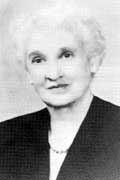
The 1920's and 1930's were decades of intense interest in sports. Various types were actively promoted by the Athletic Association. For several years, in the late 1920's, varsity teams were even organized in swimming and tennis. Basketball, however, aroused the greatest support and enthusiasm at H.T.C. ( Harrisonburg Teachers College ). Intercollegiate basketball was inaugurated during the session of 1920-21 when a varsity team played a seven-game schedule, opening with Bridgewater and including “home and home” games with the other three normal schools. At the end of the season sweaters and letters were awarded the players. Prom the beginning the team received enthusiastic support, support which carried over into the community. When the squad played its last game at Radford it was deluged with telegrams for success from Harrisonburg business concerns. Enthusiasm ran high each year as the varsity, clad in white middy blouses, dark blue serge bloomers and long black stockings, represented the School in competition with other institutions. Members of the squad ate at special “training tables” in the dining hall to insure the best physical condition. Home games were occasions for yelling and pep meetings for days before the contest, and for a packed gym in Ashby to watch the game. When the team played away from home it was cheered by telegrams from organizations and groups of students. The arch-rival of these early varsity basketball years was Radford. In 1923, when the team returned from Radford where it had gained its first victory in three years of competition with the “Sycamores” of Radford, the members were cheered as they entered the dining hall. A high point was reached the next year when Harrisonburg had its first undefeated team—Jessie Rosen, Wilmot Doan, Sadie Harrison, Martha Cockerill, Blanche Clore and Ruth Nickell—and proudly claimed the state championship.

Basketball enthusiasm remained high throughout the twenties and on into the thirties. Those were years when girls' basketball was played on a court divided into three sections and each team had six players, a jumping center and side center in addition to two forwards and two guards. The guards played only in the section around the opponent's goal, the centers played in the middle section of the court, and the forwards remained in the area around the basket and did the shooting. The Old Girl-New Girl Game played each October, a game almost always won by the old girls usually by a lop-sided margin, whetted interest in the sport and the year's prospects each fall.
The opening of Reed Hall (now Keezell Hall) in 1926 provided a new, spacious gymnasium for the games. Season tickets were sold and year after year enthusiastic student rooters packed the sidelines and balcony to cheer the “purple and gold.” At half time the gym was often the scene of an enthusiastic snake dance. Cheerleaders led in college yells and songs such as “Roll up the score, girls, higher, higher,” “ Skinum-a-rink-a dink-a dink—Skinum-a-rink-a-do”, “Purple and Gold,” “We're Back of You Now, H. T. C.” and one, to the tune of “Stars and Stripes Forever”, which particularly caught the spirit of H. T. C.:
With a step that is steady and strong
For old Harrisonburg march along.
True to the colors we bear,
The purple and gold so fair.
In bonds of true fellowship
That the days and the years cannot sever,
United in friendship we stand
For school, for friends,
For Alma Mater forever.

The teams of H. T. C., superbly coached by Mrs. (Althea Loose) Johnston (see “From Normal School to JMU”) and passing the lucky rabbit's foot from one captain to the next, won most of their games. Over the space of one seven-year period there were four undefeated seasons. The first two of these came when basketball was at its peak with the great teams of 1929 and 1930, winners of sixteen straight games. Dark blue sleeveless jersies, each with a gold H in front, worn over white shirts had replaced the middy blouses since 1925, but the bloomers and long stockings remained. The team of 1929 more than doubled its opponents' score in every game but one, and ended the season with a 90 to 6 whomping of Fredericksburg. It was an exciting year. When Radford, still the arch-rival, played at Harrisonburg, the student body turned out in white and carried purple and gold sticks to cheer as their varsity won 49 to 8. In the next game the victim was the Savage School of Physical Education of New York. This great H. T. C. team was captained by Clelia (“Cotton-top”) Heizer at guard and numbered as its other stars Elizabeth (“Libber”) Miller as right guard, Frances Rolston and tall Elsie (“Quizzy”) Quisenberry as centers, and Esther (“Smittie”) Smith and Anna Lyons Sullivan as sharpshooting forwards. The centers and forwards returned the next year and, supplemented by Evelyn Bowers, Julia Duke and pugnacious little Mary (“ Wally”) Farinholt as guards, went through a second undefeated season. Their victims included three out-of-state teams—Slippery Rock Teachers, New York University and Savage, the first defeat handed Savage on its home floor in eight years. The other undefeated seasons came in 1934 and 1935 under the leadership of Captain Emily (“Pitt”) Pittman, star forward. By this time—in fact since 1933—varsity girls could play without the long black stockings that had been virtually a Harrisonburg trademark for a quarter century. (In Mrs. Johnson's 22 years as coach, her teams had an overall record of 106-33-5, a.753 winning percentage.)
-- Dr. Raymond C. Dingledine Jr.
Madison College, the First Fifty Years, 1908-1958
